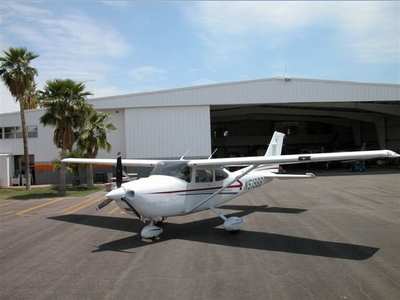Wed, Feb 01, 2012
Avionics Master Switch Seeing Accelerated Failure Rate In Some
Airplanes
The FAA has issued an SAIB (Special Airworthiness Information
Bulletin) concerning he avionics master switch on Cessna Aircraft
Company (Cessna) Model 172R, 172S, 182T, T182T, 206H and T206H
airplanes. There is a potential for an accelerated rate of failure
of the switch, which may result in the loss of avionics equipment
on Garmin G1000-equipped airplanes.
Cessna 182T file Photo

Although failure of the switch can result in loss of equipment,
these airplanes are designed such that avionics equipment necessary
for the pilot to continue safe flight and landing are still
maintained through the aircraft’s electrical system. At this
time, this airworthiness concern is not considered an unsafe
condition that would warrant an AD.
The SAIB is the result of reports received by the FAA indicating
a trend of failures associated with components of the Garmin G1000
avionics suite in the Cessna single-engine models identified above.
After investigating further and coordinating with Cessna, we
determined that electrical contact erosion was occurring internal
to the switch. This erosion is due to power-up surge currents
caused by avionics equipment connected to one side of the switch
(Avionics Bus 2). The electrical distribution system was reviewed
for the affected models and it was found that in the event of a
complete failure of the avionics master switch, essential equipment
necessary to continue safe flight and landing will be maintained
through alternate power sources. Cessna has issued Service Bulletin
SB 11-24-02 to address this issue.
The FAA recommends that owners and operators of Cessna Models
172R, 172S, 182T, T182T, 206H, and T206H aircraft equipped with a
Garmin G1000 system:
Replace the avionics master switch (part number S3443-1-1) every
500 hours of operation following Cessna Service Bulletin
SB11-24-02, dated July 21, 2011.
If issues during power up of the avionics, where a display or other
equipment does not initially power and it requires cycling of the
avionics master switch, are experienced, further action should be
taken to isolate and identify the problem including inspection of
the switch for possible impending failure.
If any system failure is experienced in-flight or before flight,
follow the appropriate published abnormal or emergency procedures,
and have the failed system repaired before the next flight. Take
further action to isolate and identify the problem including
inspection of the avionics master switch for possible impending
failure.
More News
“While legendary World War II aircraft such as the Corsair and P-51 Mustang still were widely flown at the start of the Korean War in 1950, a new age of jets rapidly came to >[...]
Decision Altitude (DA) A specified altitude (mean sea level (MSL)) on an instrument approach procedure (ILS, GLS, vertically guided RNAV) at which the pilot must decide whether to >[...]
Aero Linx: National Aviation Safety Foundation (NASF) The National Aviation Safety Foundation is a support group whose objective is to enhance aviation safety through educational p>[...]
Also: Cal Poly Aviation Club, $$un Country, Arkansas Aviation Academy, Teamsters Local 2118 In response to two recent general aviation accidents that made national headlines, more >[...]
“The FAA is tasked with ensuring our skies are safe, and they do a great job at it, but there is something about the system that is holding up the medical process. Obviously,>[...]
 Aero-News: Quote of the Day (04.28.25)
Aero-News: Quote of the Day (04.28.25) ANN's Daily Aero-Term (04.28.25): Decision Altitude (DA)
ANN's Daily Aero-Term (04.28.25): Decision Altitude (DA) ANN's Daily Aero-Linx (04.28.25)
ANN's Daily Aero-Linx (04.28.25) Airborne-Flight Training 04.24.25: GA Refocused, Seminole/Epic, WestJet v TFWP
Airborne-Flight Training 04.24.25: GA Refocused, Seminole/Epic, WestJet v TFWP Aero-News: Quote of the Day (04.29.25)
Aero-News: Quote of the Day (04.29.25)



